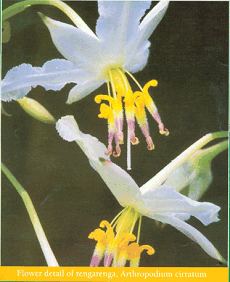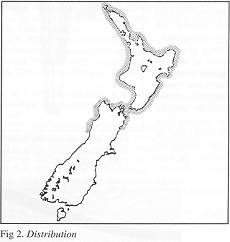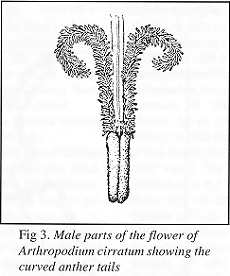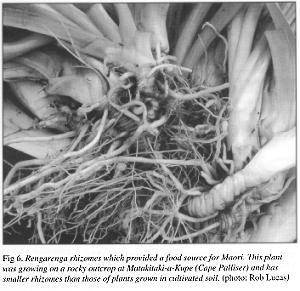
|
The
significance of rengarenga
From The New Zealand
Garden Journal (Journal of the Royal New Zealand Institute of Horticulture),
Vol. 1, No. 2, June 1996, pp. 19-21.
The paper discusses the importance of rengarenga to Maori and evidence outlining the use of the plant as a food source and for medicinal, spiritual and other cultural purposes including its representation in kowhaiwhai patterns is presented based on historical and recent documents, and oral history. Introduction Rengarenga Arthropodium
cirratum is a lily which colonises rocky coastal areas from
the North Cape to a southern limit from Kaikoura to Greymouth. It
is often referred to as the New Zealand rock lily. An alternative Maori
name for the plant, maikaika, is shared with two native orchids
(Orthocerus strictum and Thelymitra pulchella)
that have similar starchy, edible root-like tubers. (Crowe
1995). Rengarenga is not common
in the wild in some regions of its habitat and is classified by
the Department of Conservation as being vulnerable in the Wellington
conservancy. The plant forms extensive colonies and in summer bears
panicles of six petalled white flowers on 30 cm stalks. The flowers
have purple and yellow stamens which are curled at the ends and
give rise to the specific name cirratum (curled). Significance to Maori Information about the
importance of rengarenga as a food source for Maori and its cultural
and spiritual significance was recorded by William Colenso who,
along with Elsdon Best, published much of the early ethnobotanical1
information in New Zealand. Colenso also recorded information about
the medicinal properties of the plant and how it was utilised by
Maori for that purpose.
Spiritual
Kerr 1995 (pers. comm.) stated that this proverb relates to the Maori land wars of the 1860's in the Waikato when the Waikato Maori were being forced back into the King Country and were threatened with the loss of their land. The proverb means - even though we may be dispossessed, we will survive on what we can gather from the fruits of the land. Riley (1994: 116) noted
in Maori Healing and Herbal - New Zealand Ethnobotanical Sourcebook,
that an inner meaning indicates that men as fodder for the controller
of war, Tu, will be plentiful for that purpose. It is claimed that
the spirits of such warriors, when killed in war, travelled to Cape
Reinga in great style, carrying weapons, dancing and talking and
making much noise. The spirits of those dying of natural causes,
on the other hand, travelled to Cape Reinga silently waving branches
of rengarenga as they moved. Riley also noted that rengarenga once
lay in a place of honour on the tuahu (sacred place) at Whangara
(north of Gisborne). Kowhaiwhai patterns
Neich 1993: 34 noted
that some, have mythological associations and that the chief connotation
of kowhaiwhai seems to relate to ideas of genealogy and descent.
The rengarenga flower is represented in several kowhaiwhai patterns
underlining the significance of the plant to Maori. Colenso 1891: 460 in
describing kowhaiwhai patterns wrote: "One in particular,
I may mention and explain: this pattern was called rengarenga, from
being an imitation of, or an ideal association with the curved anthers
of the flowers of that plant, the New Zealand lily (Arthropodium
cirratum). Here we have another curious and pleasing instance
of coincidence of ideas in natural close observation and naming
between two widely opposite peoples, the ancient New Zealander and
the highly civilised European — the German botanist
Forster who accompanied Cook on his second voyage to New Zealand
and who gave the appropriate specific name of cirratum to this plant
from its peculiar closely-curved and revolute anthers" (see fig
3). Despite an extensive
search, the kowhaiwhai pattern described by Colenso could not be
located nor could any other patterns incorporating rengarenga anther
patterns. Simmons 1995 (pers. comm.)
noted that the flowers of the rengarenga plant were sometimes incorporated
into other kowhaiwhai patterns3 such as that shown
in Fig 4. This was in the house Te Poho o Haraina which
stood at Patutahi near Gisborne and was the house of Wi Pere
of the Rongowhakaata iwi. It was opened in 1885 and
burnt down in 1947. The basic pattern is similar to that identified
by Hamilton 1896: 127, as Ngutukura (the whale) but this
version incorporates stylised rengarenga flowers. Simmons indicated
that these four petalled flowers (rengarenga actually has six petals)
were known as popoa rengarenga and refer to the gods, whereas
flowers with more than four petals refer to men. The pattern shown in
Fig 5, is reported by Simmons to be from a house in the Bay of Plenty-East
Coast area and was painted on narrow flat rafters. Simmons noted
that the stalks and unopened flowers of rengarenga were rendered
quite realistically. Food Colenso (1880: 30) recorded
that rengarenga was one of the few native plants cultivated by Maori
for food. He wrote: "The thick fleshy roots
of the New Zealand lily Arthropodium cirratum, were also
formerly eaten, cooked in the earth oven. This plant grows to a
very large size in suitable soil, and when cultivated in gardens.
From this circumstance, and from not unfrequently noticed it about
old deserted residences and cultivations, I am inclined to believe
that it was also cultivated." The author observed that
wild plants growing in their natural habitat tend to produce small
tightly congested rhizomes and often grow on rock faces almost like
epiphytes, whereas the same plants grown in cultivated soil, produce
much larger rhizomes. Riley 1994: 416 noted
that rengarenga rhizomes when roasted or cooked in a steam oven
(umu) have a flavour not unlike potato. This was confirmed by the
author who reported that after steaming rhizomes for 60 minutes,
the younger sections nearest the growing points, were soft and tender,
while the older more mature sections were very fibrous and not as
palatable. The rhizomes of a related plant, vanilla lily Arthropodium milleflorum are eaten by Australian Aborigines (Sainty l989: 46). Medicinal Maori were highly skilled
in using herbs in conjunction with spiritual healing (Riley 1994:
9). Riley noted that boils
and abscesses were one of the main surgical complaints that afflicted
Maori in pre-European times and into the early 20th century and
referred to the report of the Colonial Hospital Wellington, for
the year 1848 which listed abscesses as fourth equal with lung inflammation
as cause of death among Maori patients. Riley also noted in Maori
Healing and Herbal that "no less one-fifth of the
some 200 plants in this book are used to treat boils and abscesses."
More recent publications
on medicinal uses of native plants including Riley 1994, and Brooker
et al. 1981: 63, refer to the above two publications (White
and Colenso) for medicinal uses of Arthropodium cirratum. Enquiries made by the author indicate that rengarenga does not appear to be used for medicinal purposes today. Notes
Acknowledgments The following individuals provided assistance and advice in the preparation of this study:
References Brooker, S.G., R.C. Cambie and R.C. Cooper. 1981. New Zealand Medicinal Plants. Auckland: Heinemann Publishers. Colenso, W. 1868. Geographic and Economic Botany of the North Island of New Zealand. Transactions and Proceedings of the New Zealand Institute. 1: 232-83. Colenso, W, 1880. On the Vegetable Food of the Ancient New Zealanders. Transactions of the Royal Society of New Zealand. 13: 338. Colenso, W. 1891. Reminiscence of the Ancient Maoris. Transactions and Proceedings of the New Zealand Institute. 24: 460. Crowe, A. 1995. Which Coastal Plant? Auckland: Viking New Zealand. Department of Conservation Wellington Conservancy Draft Conservation Management Strategy 1994-2003. 1994 Volume 1. Appendix 1. PO Box 5086, Wellington. Hamilton, A. 1896. The Art Workmanship of the Maori Race in New Zealand. Dunedin: Fergusson and Mitchell. University of Otago. Kerr, Hoturoa. 1995. personal communication. Neich, R. 1993. Painted Histories. Auckland: Auckland University Press. Parsons, M.J. 1992. Ethnobotany — A Maori Perspective. Proceedings of the Royal New Zealand Institute of Horticulture Annual Conference 1992. Riley, M. 1994. Maori Healing and Herbal. New Zealand Ethnobotanical Sourcebook. Paraparaumu, New Zealand: Viking Sevenseas. Sainty, G.R. 1989. Wildthings, plants and animals commonly seen around Sydney. Sydney, Australia: Sainty and Associates. Simmons, D.R. 1995. personal communication. Tregear, E. 1904. The Maori Race. Whanganui: A.D.Willis. White, J. 1883. Maori Pharmocopia. MS Papers 75 B35/11 Alexander Turnbull Library, Wellington. Williams, H.W. 1992. Dictionary of the Maori Language. 7th edition. Government Print Publications Ltd.
Web-notes:
|
Home | Journal
| Newsletter | Conferences
Awards | Join
RNZIH | RNZIH Directory | Links
© 2000–2025 Royal New Zealand Institute of Horticulture
Last updated: March 1, 2021

 Reproduced
from an article by the late Graham Harris
Reproduced
from an article by the late Graham Harris Rengarenga
is recorded by Tregear (1926: 496) as being one of the five sacred
mauri or talismans, those things possessed of the soul of the Maori
people. It is referred to in the whakatauaaki or proverb
"Me ai ki te hua o te rengarenga me whakapakari ki te
hua o te kawariki" — may you be nourished by the
fruit of the rengarenga and of the kawariki2
(Williams 1992: 251).
Rengarenga
is recorded by Tregear (1926: 496) as being one of the five sacred
mauri or talismans, those things possessed of the soul of the Maori
people. It is referred to in the whakatauaaki or proverb
"Me ai ki te hua o te rengarenga me whakapakari ki te
hua o te kawariki" — may you be nourished by the
fruit of the rengarenga and of the kawariki2
(Williams 1992: 251). The
rafters of Maori wharenui (meeting houses) are often decorated with
elaborate scroll-like patterns known as kowhaiwhai. These usually
are painted in red, white and black, although the pattern shown
in Figure 5 is grey, brown and white. The motif of the patterns
in general, represent natural objects (Hamilton 1896: 118).
The
rafters of Maori wharenui (meeting houses) are often decorated with
elaborate scroll-like patterns known as kowhaiwhai. These usually
are painted in red, white and black, although the pattern shown
in Figure 5 is grey, brown and white. The motif of the patterns
in general, represent natural objects (Hamilton 1896: 118).

 Rengarenga
was one of the plants used for the treatment of boils and abscesses
and Colenso 1868: 267 recorded that the roots of the rengarenga
were roasted and beaten to a pulp and applied warm to unbroken tumours
or abscesses. White (1883) recorded that the bottom or lower end
of the leaves is beaten into a pulp as a poultice to cure ulcers
or longstanding sores and to allay swelling of joints or limbs.
He also noted that the root of the plant was eaten in its raw state
to cure the itch, although he did not specify the exact nature of
this complaint.
Rengarenga
was one of the plants used for the treatment of boils and abscesses
and Colenso 1868: 267 recorded that the roots of the rengarenga
were roasted and beaten to a pulp and applied warm to unbroken tumours
or abscesses. White (1883) recorded that the bottom or lower end
of the leaves is beaten into a pulp as a poultice to cure ulcers
or longstanding sores and to allay swelling of joints or limbs.
He also noted that the root of the plant was eaten in its raw state
to cure the itch, although he did not specify the exact nature of
this complaint.